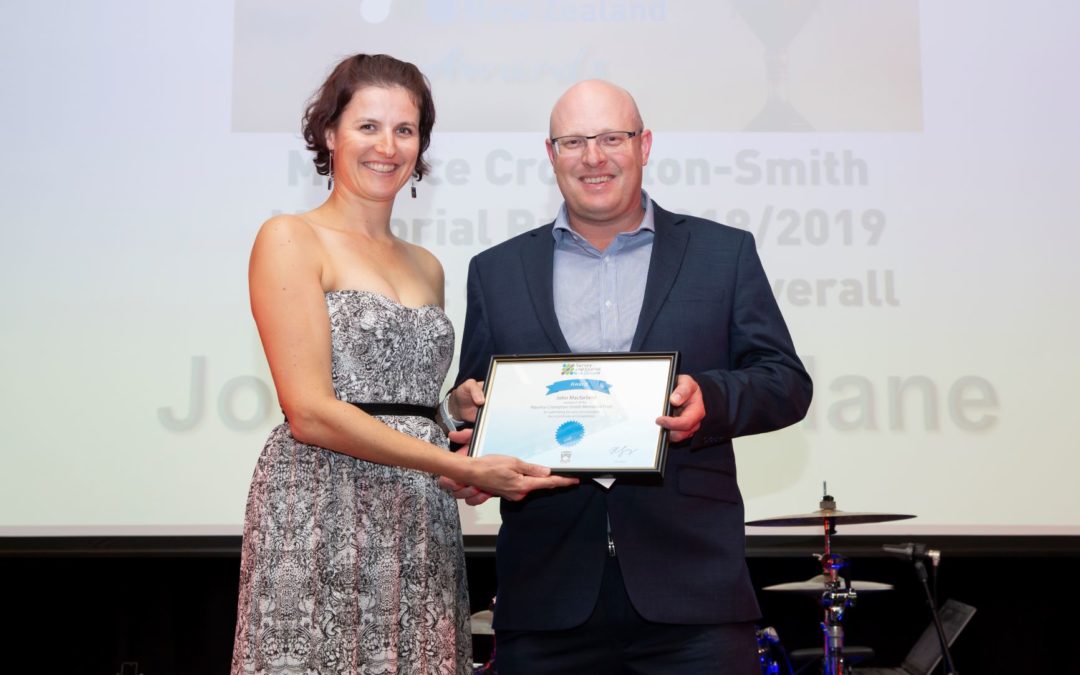Photo: Rebecca Strang, President S+SNZ and John MacFarlane
Cadastral Surveyor, John Macfarlane has enjoyed an exciting and varied career, topped of with recently winning the 2018/2019 Maurice Crompton-Smith Memorial Prize! John won the Award for his excellent project work to gain a Cadastral Surveying License.
John was presented with his award at the 130th Survey and Spatial New Zealand (S+SNZ) Annual Conference dinner in May by Rebecca Strang, President S+SNZ and Mark Dyer, Chief Executive S+SNZ (also one of the examiners). The S+SNZ Awards are designed to recognise personal achievement and to celebrate excellence and innovation in the surveying and spatial professions.
Nicola Todd, Director, Cuttriss Consultants says they are very proud of John.
“John extended an exceptional effort to achieve this award while balancing a busy home and work life. This award has reflected both John’s personal efforts but also those of Cuttriss who is renowned as an excellent training organisation. John is extremely hardworking and his achievement was no surprise to us and we are delighted for him,” says Nicola Todd.
Based out of the Cuttriss Lower Hutt office, John is a Licensed Cadastral Surveyor, a father of two and a drone pilot. John says he has really honed his skills at Cuttriss Consultants, working towards his license and on a great variety of projects. This includes UAV surveys of land fills and earthworks for subdivision design and quantities, site surveyor for a number of small to large subdivisions including The Masonic retirement village in Wainuiomata, engineering design and contract supervision of a 20 Lot subdivision at Meremere Street, Wainuiomata, to name but a few.
“I’m very happy with this award. I put a lot of work into these projects, and it was a busy time as I have a young family. Receiving the award is great recognition for myself, and Cuttriss who helped me a lot,” says John Macfarlane.
From the London Underground to the Great Kiwi Outdoors
What does it take to be a Cadastral Surveyor? We talked to John about his experience, the process to become licensed, and what he likes about being a Cadastral Land Surveyor at Cuttriss Consultants.
John’s career journey has taken him all the way from surveying the Piccadilly Line on the London Underground at night, for the design to handle larger trains and surveying multi-level underground stations for modernisation, including London Bridge station which had a skyscraper (The shard) built on top of it – to now in Wellington, flying drones to survey.
What’s is like to be a Cadastral Surveyor?
John joined Cuttriss Consultants in 2016, with over 10 years’ experience. Based in Lower Hutt, John has developed his skills at Cuttriss Consultants, working towards his license, training to be a drone pilot and working on a variety of projects.
“Cuttriss is a great company to work for. They are focused on quality work and provide lots of support and mentoring. It’s easier to get the right kind of experience on the right project,” says John Macfarlane.
What is your career background?
After completing my degree at the University of Otago, I started work in Napier with Opus, near my home town of Clive just 10 minutes south, before heading overseas to London undertaking surveying projects for the London Underground, local councils and infrastructure projects. I returned to New Zealand after four years, for the lifestyle, and then worked for MWH in Wellington mainly focusing on large infrastructure projects. I’ve now been at Cuttriss Consultants for three years.
What work did you do on the London Underground and what was it like?

I surveyed on two projects relating to the London Underground. One on the Picaddily line and the other, surveying train stations for modernisation. Both were interesting and very different from anything in New Zealand but came with unsociable night hours.
I led a field team to survey key features and precise level the entire Piccadilly line on the London Underground. Multiple teams worked on this project and the end goal was to provide a survey which will be used to design for larger trains. We worked at night, six days per week when the tube was shut down and we were chaperoned by ‘protective masters’ to ensure nothing was ‘live’. It was interesting to see ‘ghost stations’ – stations that are not in use anymore, ones you don’t notice when passing on the tube.
The second project was for a survey company (also working at night) to survey the underground stations on multiple lines, with a view to modernisation. For example, London Bridge station needed to be modernised as a new skyscraper (The Shard) was built on top of it.
“I had to think in ‘3D’ for this project, considering multiple station levels, and I really enjoyed this challenge.”
How does this work differ to what you do at Cuttriss Consultants?
The survey aspects (techniques) are similar to what we do at Cuttriss Consultants but of course, the environment was completely different. We don’t have that kind of infrastructure in Wellington. I enjoy the varied project work at Cuttriss and it’s great to work outdoors again.
Can you describe your typical week?
Every week brings new projects and new challenges – there’s a huge variety of project work at Cuttriss Consultants from site surveying on big developments, to land transfer surveys, drone earthwork surveys, grid line surveys and managing subdivision projects.
How did you become a Licensed Cadastral Surveyor at Cuttriss Consultants?
Although experienced, I really wanted to become a Licensed Cadastral Surveyor and achieved this goal in September 2018. Being a licensed surveyor opens up the types of projects that I can work on, and does bring more responsibility. Cadastral surveys can only be undertaken by a licensed cadastral surveyor or a person acting under the direction of a licensed cadastral surveyor.
This was a big time commitment for me, particularly as I needed to balance the extra study with my young family. Cuttriss Consultants has been great, providing lots of support like mentoring, training and experience in the right types of projects.
To become a Licensed Cadastral Surveyor you do project work (cadastral surveying, engineering and project planning) that must meet specific criteria. For example, I undertook a 20-lot subdivision engineering project and critiqued a big planning project. You must also complete a challenging exam, as it’s important to know the relevant legislation.
What are the main skills/strengths you need to be a good land surveyor?
A good surveyor needs to keep up with survey methods, regulations and technology developments e.g. software. Attention to detail and having good work processes in place is important for streamlining workflow.
What do you like about your career, and what advice do you have for aspiring surveyors?
Cuttriss has a great reputation for nurturing graduates and taking them through this process. My job offers a great balance between being in the office and working on site – with plenty of variety in-between. Outside of work I enjoy time with my children, exploring the Wellington region, skiing in winter and golf when I can squeeze it in.
“Surveying is the perfect balance between office work and being in the field.”
If the life of a Licensed Cadastral Surveyor sounds like you, first you need to complete a four year Bachelor of Surveying degree from the University of Otago. Once on the job you work towards becoming licensed.
For more information on working as a Cadastral Surveyor at Cuttriss Consultants please contact us on (04) 939-9245.




